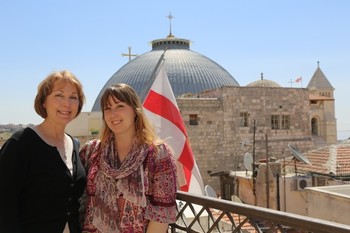Editor’s note: This is part of a series featuring two participants of the Mosaic of Peace trip to Israel/Palestine, a Presbyterian Peacemaking conference running April 28-May 10. Read past entries here, here and here. The following reflects the thoughts and views of the participant and was only slightly edited for clarity. — Bethany Daily
May 1, 2014:
So far the conference has been very engaging. One aspect that strikes me is the sincerity of the team that has put together this event. In addition, we have been honored to hear from some great people involved in the Israeli/Palestinian peace dialogue.
The hopefulness and courage of the speakers we have heard is amazing. Some of the people we are hearing from have been working on trying to promote peace in this cradle of Judaism, Christianity and Islam.
Jerusalem is a beautiful city. I’m impressed by the layers of history and the sincerity of the pilgrims who come here from all over the world. We visited the Holocaust Museum today. I heard visitors speaking in many languages as I walked through the many impressive exhibits. Perhaps the most surprising was a large tour group from Kenya.
Seeing the city of Jerusalem and witnessing the devotion of others encourages my own faith. Though the city is crowded and busy, there are amazing moments of intimacy with both the places we visit and the pilgrims who are visiting.
I am also impressed with the earnest dedication of the leaders in peacemaking from whom we have heard.
Some former colleagues are also on this journey. I hadn’t realized they were participating. In addition to participating in this very engaging experience with my daughter, I am enjoying making new friends and connecting with long-time friends from around the country.
I’m looking forward to more discovery — understanding the depth of the issues facing this part of the world and seeing more of the Bible come alive in the places we visit.
May 2, 2014:
Today we toured Jerusalem. At the Church of the Holy Sepulcher, we stood in a shoving, struggling clump of people moving at a snail’s pace up a narrow, winding stairway to touch the place tradition maintains the cross of Jesus stood. For a few moments, I, among another teeming group members, pressed toward the “tomb” of Jesus but was relieved of that burden when the tour guide came to tell us it was time to leave. One of my fellow travelers commented, “They could use some Disney organization here.” Folks “waiting” in “line” were pushy and rude in their quest to touch the place where allegedly, Jesus gave his life for the sins of the world. Wholly disregarding Jesus’ directive to “love one another,” these pilgrims to the “holy site” pushed and pressed others out of the way in their quest to touch Jesus.
Earlier in the day, the Mosaic of Peace conference participants were graciously received by the patriarchs of the Roman Catholic and of the Orthodox Church. In separate formal meetings, each spoke of the history of Christianity in Jerusalem and interfaith relationships. The Latin Patriarch commented that “one week of prayer for unity” is not enough and advocated for an “ecumenical emphasis in seminaries.” His office is looking forward to Pope Francis’ visit in the near future.
Speaking of the Israel/Palestine conflict, he stated that Palestinian Christians are the “Church of Calvary... We must bear our cross daily,” as the occupation of Israel/Palestine has stretched for “66 years.” He said that the occupation is bad for both the occupied and the occupiers, “bad to put walls, separating parishes and churches,” and that the younger generation knows nothing but occupation. Many Palestinians cannot even visit our holy places.
The Orthodox Patriarch provided history of the establishment of the church in Jerusalem. He believes that preserving the holy sites in Jerusalem is a sacred trust and that the Church has worked to maintain the “old city.” The focal point of tension is the Dome of the Rock (which our group was unable to visit.) He concluded his remarks saying, “Holiness is not something exclusive.” He spoke of the Palestinians as “displaced people,” and commented on the persecution of Christians in other countries. “Jerusalem is extremely important because it is the city of resurrection. We live with this hope, a vibrant, living hope.”
We followed the Via de la Rosa backward from the Church of the Holy Sepulcher and then were guided to the Wailing Wall in the Jewish Quarter. We joined with other faithful in offering our prayers. Then we toured parts of the old city — Jewish, Armenian and Muslim quarters. We entered the Jewish quarter through a checkpoint where our day packs passed through screening. Our guide explained that he lives in Jerusalem. “I am not a citizen,” he said, though he was born here. “I am a resident. If I leave, it would be very complicated to return. I might not be granted resident status again.”
One of the patriarchs mentioned the lack of trust that plagues their homeland. Jerusalem is beautiful — golden in the sun that shines in a bright blue sky. But it is clear that there is brokenness, and so my prayer tonight is for healing for this city and for its inhabitants.

